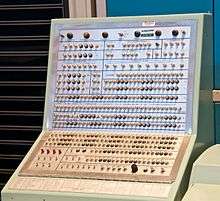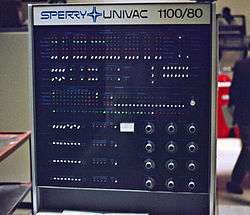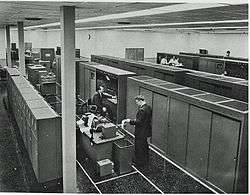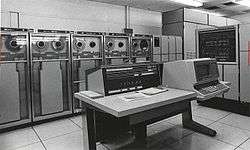UNIVAC
UNIVAC is the name of a line of electronic digital stored-program computers starting with the products of the Eckert-Mauchly Computer Corporation. Later the name was applied to a division of the Remington Rand company and successor organizations. UNIVAC is an acronym for UNIVersal Automatic Computer.
The BINAC, built by the Eckert-Mauchly Computer Corporation, was the first general-purpose computer for commercial use. The descendants of the later UNIVAC 1107 continue today as products of the Unisys company.
Univac history and structure

J. Presper Eckert and John Mauchly built the ENIAC (Electronic Numerical Integrator and Computer) at the University of Pennsylvania's Moore School of Electrical Engineering between 1943 and 1946. A 1946 patent rights dispute with the university led Eckert and Mauchly to depart the Moore School to form the Electronic Control Company, later renamed Eckert-Mauchly Computer Corporation (EMCC), based in Philadelphia, Pennsylvania. That company first built a computer called BINAC (BINary Automatic Computer) for Northrop Aviation (which was little used, or perhaps not at all). Afterwards began the development of UNIVAC. UNIVAC was first intended for the Bureau of the Census, which paid for much of the development, and then was put in production.
With the death of EMCC's chairman and chief financial backer Harry L. Straus in a plane crash on October 25, 1949, EMCC was sold to typewriter maker Remington Rand on February 15, 1950. Eckert and Mauchly now reported to Leslie Groves, the retired army general who had managed the Manhattan Project.
The most famous UNIVAC product was the UNIVAC I mainframe computer of 1951, which became known for predicting the outcome of the U.S. presidential election the following year. This incident is particularly noteworthy because the computer predicted an Eisenhower landslide when traditional pollsters all called it for Adlai Stevenson.[1] The numbers were so skewed that CBS's news boss in New York, Mickelson, decided the computer was in error and refused to allow the prediction to be read. Instead they showed some staged theatrics that suggested the computer was not responsive, and announced it was predicting 8-7 odds for an Eisenhower win (the actual prediction was 100-1). When the predictions proved true and Eisenhower won a landslide within 1% of the initial prediction, Charles Collingwood, the on-air announcer, embarrassingly announced that they had covered up the earlier prediction.[2]
Remington Rand had its own calculating machine lab in Norwalk, Connecticut, and later bought Engineering Research Associates (ERA) in St. Paul, Minnesota. In 1953 or 1954 Remington Rand merged their Norwalk tabulating machine division, the ERA "scientific" computer division, and the UNIVAC "business" computer division into a single division under the UNIVAC name. This severely annoyed those who had been with ERA and with the Norwalk laboratory.
In 1955 Remington Rand merged with Sperry Corporation to become Sperry Rand. The UNIVAC division of Remington Rand was renamed the Univac division of Sperry Rand. General Douglas MacArthur was chosen to head the company. In the 1960s, UNIVAC was one of the eight major American computer companies in an industry then referred to as "IBM and the seven dwarfs" — a play on Snow White and the seven dwarfs, with IBM, by far the largest, being cast as Snow White and the other seven as being dwarfs: Burroughs, Univac, NCR, CDC, GE, RCA and Honeywell.[3] In the 1970s, after GE sold its computer business to Honeywell and RCA sold its to Univac, the analogy to the seven dwarfs became less apt and the remaining small firms became known as the "BUNCH" (Burroughs, Univac, NCR, Control Data, and Honeywell).
To assist "corporate identity" the name was changed to Sperry Univac, along with Sperry Remington, Sperry New Holland, etc. In 1978 Sperry Rand, an old fashioned conglomerate of disharmonious divisions (computers, typewriters, office furniture, hay balers, manure spreaders, gyroscopes, avionics, radar, electric razors), decided to concentrate on its computing interests and unrelated divisions were sold. The company dropped the Rand from its title and reverted to Sperry Corporation. In 1986, Sperry Corporation merged with Burroughs Corporation to become Unisys.
Since the 1986 marriage of Burroughs and Sperry, Unisys has metamorphosed from a computer manufacturer to a computer services and outsourcing firm, competing in the same marketplace as IBM, Electronic Data Systems (EDS), and Computer Sciences Corporation. Unisys continues to design and manufacture enterprise class computers with the ClearPath and ES7000 server lines.
Models



In the course of its history, UNIVAC produced a number of separate model ranges. Early UNIVAC 1100 series models were vacuum tube computers.
The original model range was the UNIVAC I (UNIVersal Automatic Computer I), the second commercial computer made in the United States.[4] The main memory consisted of tanks of liquid mercury implementing delay line memory, arranged in 1000 words of 12 alphanumeric characters each. The first machine was delivered on 31 March 1951.
The UNIVAC II was an improvement to the UNIVAC I that UNIVAC first delivered in 1958. The improvements included magnetic (non-mercury) core memory of 2000 to 10000 words, UNISERVO II tape drives which could use either the old UNIVAC I metal tapes or the new PET film tapes, and some circuits that were transistorized (although it was still a vacuum tube computer). It was fully compatible with existing UNIVAC I programs for both code and data. The UNIVAC II also added some instructions to the UNIVAC I's instruction set.
Sperry Rand began shipment of UNIVAC III in 1962, and produced 96 UNIVAC III systems. Unlike the UNIVAC I and UNIVAC II, however, it was a binary machine as well as maintaining support for all UNIVAC I and UNIVAC II decimal and alphanumeric data formats for backward compatibility. This was the last of the original UNIVAC machines.
The UNIVAC Solid State was a 2-address, decimal computer, with memory on a rotating drum with 5000 signed 10 digit words, aimed at the general purpose business market. It came in two versions: the Solid State 80 (IBM-Hollerith 80 column cards) and the Solid State 90 (Remington-Rand 90 column cards). This computer used magnetic amplifiers, not transistors, because the transistors then available had highly variable characteristics and were not sufficiently reliable. The magnetic amplifiers were based on tiny magnetic cores with two wire windings. The magnetic amplifiers required powerful pulses of heavy current produced by a transmitter-type vacuum-tube, of a type still used in amateur radio final amplifiers. Thus the Solid State depended, at the heart of its operations, on a vacuum tube.
The UNIVAC 1100/2200 series is a series of compatible 36-bit transistorized computer systems initially made by Sperry Rand. The series continues to be supported today by Unisys Corporation as the ClearPath Forward Dorado Series.[5]
- Remington Rand 409 was a control panel programmed punched card calculator, designed in 1949.
- The UNIVAC 418 (aka 1219) was an 18-bit word core memory machine. Over the three different models, more than 392 systems were manufactured.
- The UNIVAC 490 was a 30-bit word core memory machine with 16K or 32K words; 4.8 microsecond cycle time. The UNIVAC 1232 was a military version of the 490.[6]
- The UNIVAC 492 is similar to the UNIVAC 490, but with extended memory to 64K 30-bit words.
- The UNIVAC 494 was a 30-bit word machine and successor to the UNIVAC 490/492 with faster CPU and 131K (later 262K) core memory. Up to 24 I/O channels were available and the system was usually shipped with UNIVAC FH880 or UNIVAC FH432 or FH1782 magnetic drum storage. Basic operating system was OMEGA (successor to REX for the 490) although custom operating systems were also used (e.g. CONTORTS for airline reservations).
- The UNIVAC 1004 was a plug-board programmed punched card data processing system, introduced in 1962, by UNIVAC. Total memory was 961 characters (6 bits) of core memory. Peripherals were a card reader (400 cards/minute), a card punch (200 cards/minute) using proprietary 90-column, round-hole cards or IBM-compatible, 80-column cards, a drum printer (400 lines/minute) and a Uniservo tape drive. The 1004 was also supported as a remote card reader & printer via synchronous communication services. A U.S. Navy (Weapons Station, Concord) 1004 was dedicated to printing from tape as a means of offloading the task from their Solid State 80 mainframe, which produced the tapes. A plug-board program called Emulator was widely installed to convert 1004s to stored-program operation, reading in instructions from program decks of cards which determined the processing of the following data decks. Once installed, Emulator was rarely removed as it could run the machine as desired and, as almost every machine function was used, it was physically heavy from the sheer mass of installed jumpers filling nearly the entire board. Emulator was not a Univac product, rather it was built by each customer, a tedious task. Its heavy use of the 1004's program-branching reed relays, called selectors, caused increased failures, later solved by the use of electronic selectors in the follow-on 1005.
- The UNIVAC 1005, an enhanced version of the UNIVAC 1004, was introduced in February 1966. The main improvement over the 1004 was conversion from the plug-board program to an internal stored program. The machine saw extensive use by the US Army, including the first use of an electronic computer on the battlefield. Additional peripherals were also available including a paper tape reader and a three pocket stacker selectable card read/punch. The machine had a two-stage assembler (SAAL - Single Address Assembly Language) which was its primary assembler; it also had a three-stage card based compiler for a programming language called SARGE. 1005s were used as some nodes on Autodin.
- The UNIVAC 1050 was an internally programmed computer with up to 32K of six-bit character memory, which was introduced in 1963. It was a one-address machine with 30-bit instructions, had a 4K operating system and was programmed in the PAL assembly language. The 1050 was used extensively by the U.S. Air Force supply system for inventory control.
- The UNIVAC 9000 series (9200, 9300, 9400, 9700) was introduced in the mid-1960s to compete with the low end of the IBM 360 series. The 9200 and 9300, which differed in CPU speed and maximum memory capacity (16K for the original 9200 vs 32K for the other variants) implemented the same 16-bit modified subset of the 360 architecture as the Model 20, while the UNIVAC 9400 implemented a subset of the full 360 instruction set. This didn't violate IBM patents or copyrights; Sperry got the rights to "clone" the 360 as settlement of a lawsuit concerning IBM's infringement of Remington Rand's core memory patents. The 9400 was roughly equivalent to the IBM 360/30. The 9000 series used plated wire memory, which functioned somewhat like core memory but used a non-destructive read. Since the 9000 series was intended as direct competitors to IBM, they used 80-column cards and EBCDIC character encoding. Memory capacity started as low as 8K byte primary storage for a batch-configured system. Optionally a disk drive subsystem could be added, with 8414 5MB disk drives as well as tape drives, using the Uniservo VI.
- The UNIVAC Series 90:
- High-end: (90/60, 90/70, 90/80): The high-end Series 90 machines were successors to the high-end UNIVAC 9000 machines, but added virtual memory and thus were similar, or equivalent, to later IBM System/370 mainframes.
- Low-end: (90/30, 90/25, 90/40): Separately from the high-end series, Sperry Univac introduced the Univac 90/30 in about 1975 to provide an upgrade path for 9x00 users and to compete with IBM's System 3. It used a disk operating system and had either a 300 or 600 lines per minute printer, a card reader, optionally a card punch, a console (Uniscope 100), attached disk drives that had removable disk packs, several 1600 or 6250 BpI tape drives, and an optional communications controller supporting up to 16 terminals (later 32) The standard disk drive was the 8416 which held a multi-layer platter removable disk pack that held approximately 29 million bytes. The 8418 drive was an enhanced version that supported both 29MB and "double-density" 58MB disk packs. These disk drives operated on the IDA (Integrated Disk Adapter). There was also an optional 8430 drive with a 100MB capacity that operated on a separate high speed selector channel. Available tape drives were the Uniservo 10 (Mux Channel) and Uniservo 14 (Selector channel). The optional Selector Channel also enabled the use of other high speed devices such as the 1200 lpm 0776 printer or the 2000 lpm 0770 printer. The machine had either 4K or 16K memory chips, and typical machines had between 128 to 512 KiB memory. It ran an OS called OS/3, and could run up to 7 jobs at one time, not counting various OS extensions such as the print spooler and telecommunications access (ICAM). It was an upgrade path for users who had outgrown the IBM System/3. It ran Cobol-74, RPG2, Fortran, and Assembler. The instruction set of the 90/xx series was implemented in microcode and was loaded into control storage as part of the boot up process, before loading the operating system.
- Shortly after the 90/30 was introduced, Sperry Univac introduced the 90/25 which was the same basic hardware, however had an option for a smaller 80 column card reader and was a bit slower. The machine executed 3 instructions and then a NOP (no op) to slow it down, as nearly every component was identical to the 90/30). Later a 90/40 model was added, with improved performance from a faster clock rate (cycle time of 500ns vs 600ns), pre-fetching of the next instruction, and greater maximum main memory capacity (1M vs 512K).
- The Sperry UNIVAC System 80 series: The entire 90/xx series was eventually replaced in 1981 by the System 80, a Sperry-badged, IBM/360-like mainframe actually developed and engineered by Mitsubishi in Japan.
Operating systems
The 1107 was the first 36-bit, word-oriented machine with an architecture close to that which came to be known as that of the "1100 Series." It ran the EXEC II operating system, a batch-oriented second-generation operating system, typical of the early to mid-1960s. The 1108 ran EXEC II and EXEC 8. EXEC 8 allowed simultaneous handling of real-time applications, time-sharing, and background batch work. Transaction Interface Package (TIP), a transaction-processing environment, allowed programs to be written in COBOL whereas similar programs on competing systems were written in assembly language. On later systems, EXEC 8 was renamed OS 1100 and OS 2200, with modern descendants maintaining backwards compatibility. Some more exotic operating systems ran on the 1108—one of which was RTOS, a more bare-bones system designed to take better advantage of the hardware.
The affordable System 80 series of small mainframes ran the OS/3 operating system which originated on the Univac 90/30 (and later 90/25, and 90/40).
The UNIVAC Series 90 first ran with Univac developed OS/9, which was later replaced by RCA's Virtual Memory Operating System (VMOS). RCA originally called this operating system Time Sharing Operating System (TSOS), running on RCA's Spectra 70 line of virtual memory systems and changed its name to VMOS before the Sperry acquisition of RCA CSD. After VMOS was ported to the 90/60, Univac renamed it VS/9.
Trademark
UNIVAC has been, over the years, a registered trademark of:
- Eckert-Mauchly Computer Corporation
- Remington Rand Corporation
- Sperry Corporation
- Sperry Rand Corporation
- Unisys Corporation
See also
References
- ↑ Brinkley, Alan. American History: A Survey. 12 ed.
- ↑ Randy Alfred, "Nov. 4, 1952: Univac Gets Election Right, But CBS Balks", This Day in Tech , Wired
- ↑ Dvorak, John C. (2006-11-25). "IBM and the Seven Dwarfs — Dwarf One: Burroughs". Dvorak Uncensored. Retrieved 2010-07-20.
- ↑ BINAC, mentioned above, was the first.
- ↑ "ClearPath Forward Dorado Systems". Unisys.
- ↑ "Computer, UNIVAC 1232".
- David E. Lundstrom: A Few Good Men from Univac, ISBN 0-7351-0010-1
- Nancy Beth Stern, From Eniac to UNIVAC: An Appraisal of the Eckert-Mauchly Computers, ISBN 0-932376-14-2
- Arthur L. Norberg, Computers and Commerce: A Study of Technology and Management at Eckert-Mauchly Computer Company, Engineering Research Associates, and Remington Rand, 1946-1957 (History of Computing) (Hardcover), ISBN 0-262-14090-X
- James W. Cortada, Before the Computer: IBM, NCR, Burroughs, and Remington Rand and the Industry They Created, 1865-1956 (Studies in Business and Technology), ISBN 0-691-05045-7
| Wikimedia Commons has media related to UNIVAC. |
External links
- UNIVAC Conference Oral history on 17-18 May 1990. Charles Babbage Institute University of Minnesota, Minneapolis. 171-page transcript of oral history with computer pioneers involved with the Univac computer, held on 17–18 May 1990. The meeting involved 25 engineers, programmers, marketing representatives, and salesmen who were involved with the UNIVAC, as well as representatives from users such as General Electric, Arthur Andersen, and the U.S. Census.
- Oral history interview with Isaac Levin Auerbach Oral history interview by Nancy B. Stern, 10 April 1978. Charles Babbage Institute, University of Minnesota, Minneapolis. Auerbach recounts his experiences at Electronic Control Company (later the Eckert-Mauchly Computer Company) during 1947-1949. He discusses the BINAC computer project for Northrop Aircraft, the UNIVAC, as well as the roles of the National Bureau of Standards, Northrop Aircraft, Raytheon, Remington Rand, and IBM.
- UNIVAC Memories;
- Unisys History Newsletter.
- Universal Automatic Computer Model II
- UNIVAC 1004 80/90 Card Processor
- The Case 1107
- Unisys History Newsletter. Volume 1, Number 3
- UNIVAC timeline
- A still functional UNIVAC 9400 in a German computer museum
- UNIVAC Simulator 1.2 – by Peter Zilahy Ingerman; Shareware simulator of the UNIVAC I and II
- UNIVAC I/II console photos, 1948-1955 marketing documentation and flash video (Off The Broiler blog)
- UNIVAC Television Advertisement from the Internet Archive
- Sperry Corporation, UNIVAC Division Photograph Collection at Hagley Museum and Library
- Sperry Rand Corporation, Univac Division records at Hagley Museum and Library
- Sperry-UNIVAC records at Hagley Museum and Library
- Remington-Rand Presents the Univac video


